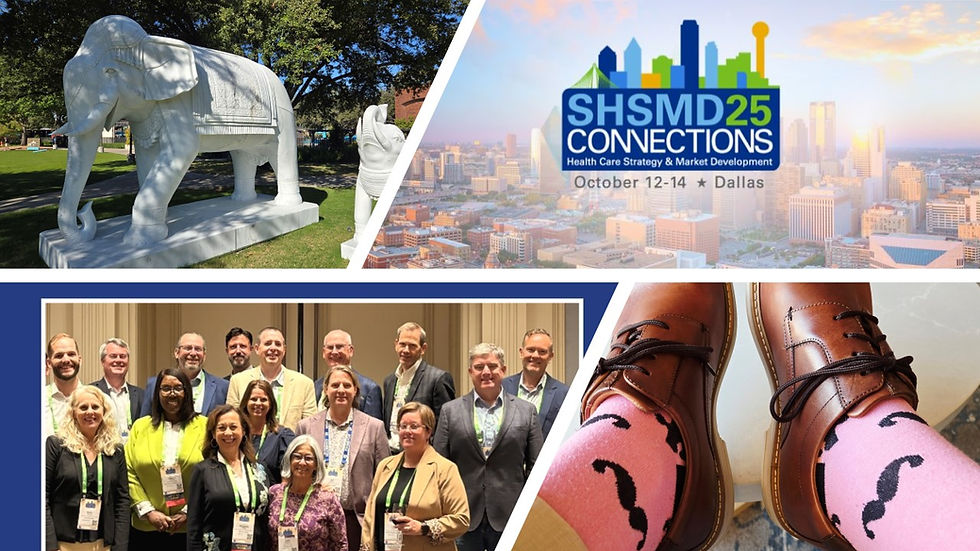HMPS 2022 recap: Facing 'uncomfortable truths' to drive change in healthcare
- Alan Shoebridge

- May 19, 2022
- 4 min read
After taking more than a two-year hiatus from in-person conferences, it was great to join several hundred marketers, communicators and other healthcare professionals at the Healthcare Marketing & Physician Strategies Summit to talk about the state of our industry. It’s always energizing to share ideas, hear case studies and make new connections. Last week's three-day session in Salt Lake City was no exception.
Saying healthcare is going through a difficult time almost feels like a cliché. Yet that sentiment is stronger than ever in 2022. A slower than expected recovery from COVID-19, new entrants (aka the disruptors), staffing shortages and declining brand affinity are just a few of the challenges we’re all dealing with right now. As Nate Kauffman told the audience during the ending keynote, everyone working in healthcare has to face some “uncomfortable truths” and build strategies to respond if they aren't already doing so.
At times, it can feel overwhelming to deal with all the challenges our industry is facing. The good news is that everyone seems focused on finding solutions to help drive positive changes that will benefit the patients we serve and build a sustainable financial future. If you didn’t attend the conference, I hope these key takeaways provide a good summary.
Highlights from each day’s conference sessions
👇 Cheat sheet: Get my seven-slide summary 👇
💡 Day 1 takewaways
Disruptive and the traditional: What do consumers say
Dean Browell, Rob Klein and Laila Waggoner
“The biggest disruptor of all might be that COVID has reset consumer expectations.”
“People want things faster. Why not in healthcare?”
“Attention spans are shorter. Advertising has to be simple, meaningful and repetitive. The brand is the star.”
“Disruptors aren’t just Amazon or Walmart: They are COVID, staffing, decreased brand preference in market, M&A, partnerships and more.”
“The disruptors are at best a frenemy.”
“Consumer trust in healthcare is slipping.”
“Strong brands take transactions and create relationships.”
The CMO/CIO Partnership: Focus on the Consumer
Chris Hemphill, Edward Marx and Paul Matsen
“Think abundance. There is enough for everyone. Let other parts of the organization lead the way.”
“Everyone needs to collaborate and work together on the digital strategy.”
"The focus always has to be on making the experience better for the patient."
"Marketers need to understand where they can partner to have impact."
"Build trust. Learn about other parts of the organization and develop relationships."
"Let others get wins."
💡💡 Day 2 takeaways
Navigating the C-Suite
Susan Alcorn, Michael Knecht, Gayle Sweitzer and Beth Toal
“Relationships with the C-suite need to be built proactively so that you can respond quickly and effectively when a crisis comes up.”
“Set expectations with your CEO for what happens if PR/Communication teams aren’t well-informed and kept in the loop.”
"Don't say yes or no right away. Build a thoughtful plan."
“If you lose the trust of the community your brand is dead.”
Growing Share of Health: The Case for Patient Retention & Loyalty
Don Stanziano and Ben Texter
“Adjusting clinic workflows to support marketing efforts is challenging.”
“Real engagement comes from embedding conversations into the clinic workflow.
“Health systems have some built-in advantages in that they already have access to the patients.”
Building Strong Employee Relationships
Maureen Richmond and Kirsten Lecky
“There are very few true crisis situations and lots of shenanigans.”
“Agility, transparency, follow-through and authenticity are the key to effective internal communication.”
“To be authentic towards others, you should be empathetic towards yourself.”
“To reach employees, we need to focus our energies.”
Can New & Traditional Healthcare Players Co-Exist?
Me, Vipul Vyas and Kirsten Anderson, M.D.
I took part in this panel discussion, and my answer to this question is that we HAVE to co-exist. Given the shortage of clinicians and lack of adequate care for most communities, we need both new and traditional healthcare players to work together to provide better healthcare. How that will be done remains to be seen. However, I think every progressive traditional healthcare provider is taking this situation very seriously and working on strategies that will protect the future of their business models and improve care to those they serve.
💡💡💡 Day 3 takeaways
Strategic Resilience: Winning in the Post-COVID, Value-Based Environment
Nate Kaufman “When people are sick, they want to be seen. That’s what they care about.” “What matters to them: access/convenience; service; optimal outcomes; affordability.” “The move from ‘volume to value’ has been disappointing.” “People who consume the most healthcare, do not shop for it.” “10% of the population accounts for 70% of the spending – mostly on chronic conditions. These people are going to specialists. Population health means having the right programs to serve them.” “Hospitals are not going away, but there will be consolidation.” “We have to be free of denial, nostalgia and hubris to change.” “You can’t fight gravity, but you can use it to your advantage.” Embrace Transparency to Transform the Experience
Suzanne Hendery, Karla Cardoza and Andrew Ibbotson “77% of consumers say they are more likely to make a provider appointment if providers have online reviews and star ratings.” "84% of people trust online reviews as much as recommendations from family and friends." “Combining the patient experience function into the marketing/communication structure helps drive change and improve understanding.” The Good, the Bad & the Ugly: Exploring the 3 Hottest Trends
Hollie Adams and Tim Stewart “Employee recruitment and retention is a major issue for every health system.” “There is a growing gulf between frontline providers and healthcare leaders.” “Leadership turnover is making it difficult for maintaining a sustainable culture.” “More than half the healthcare workforce is burned out.” “The desirability of working in healthcare has dropped by more than 10%.” “Feelings of burnout won’t be improved until we are truly out of crisis mode.”
---




Comments